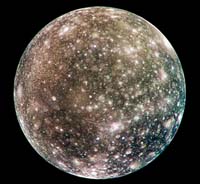A spiky landscape of bright ice and dark dust shows signs of slow but active erosion on the surface of Jupiter's moon Callisto in new images from NASA's Galileo spacecraft.
The pictures taken by Galileo's camera on May 25 from a distance of less than 138 kilometers, or about 86 miles, above Callisto's surface give the highest resolution view ever seen of any of Jupiter's moons.
"We haven't seen terrain like this before. It looks like erosion is still going on, which is pretty surprising," said James Klemaszewski of Academic Research Lab, Phoenix, Ariz.
Klemaszewski is processing and analyzing the Galileo Callisto imagery with Dr. David A. Williams and Dr. Ronald Greeley of Arizona State University, Tempe. The images were released by NASA's Jet Propulsion Laboratory, Pasadena, Calif., which manages the Galileo mission.
Callisto, about the same size as the planet Mercury, is the most distant of Jupiter's four large moons. Callisto's surface of ice and rock is the most heavily cratered of any moon in the solar system, signifying that it is geologically "dead."
There is no clear evidence that Callisto has experienced the volcanic activity or tectonic shifting that have erased some or all of the impact craters on Jupiter's other three large moons.
The jagged hills in the new images may be icy material thrown outward from a large impact billions of years ago, or the highly eroded remains of a large impact structure, Williams said. Each bright peak is surrounded by darker dust that appears to be slumping off the peak.
"They are continuing to erode and will eventually disappear," Klemaszewski said. One theory for an erosion process is that, as some of the ice sublimes away into vapor, it leaves behind dust that was bound in the ice.
The accumulating dark material may also absorb enough heat from the Sun to warm the ice adjacent to it and keep the process going. The new images show portions of the surface where the sharp knobs have apparently eroded away, leaving a plain blanketed with dark material.
The close-up images show craters as small as about 3 meters (10 feet) across, though not as many as some predictions anticipated. One scientific goal from the high-resolution images is to see how many small craters are crowded onto the surface.
Crater counts are one way to estimate the age of a moon's surface, and since Callisto has been so undisturbed by other geological processes, its cratering density is useful in calibrating the estimates for Jupiter's other moons.


